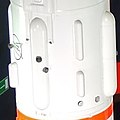 A diagram of the Rubis rocket | |
| Manufacturer | SEREB |
|---|---|
| Country of origin | France |
| Size | |
| Height | 9.60 metres (31.5 ft) |
| Diameter | 0.80 metres (2 ft 7 in) |
| Mass | 4,000 kilograms (8,800 lb) |
| Stages | 2 |
| Associated rockets | |
| Family | Pierres Précieuses ("Precious Stones") |
| Derivative work | Diamant |
| Launch history | |
| Status | Retired |
| Launch sites | CIEES/DGA Essais de missiles |
| Total launches | 10 |
| First flight | 10 June 1964 |
| Last flight | 5 July 1967 |
| First stage – NA801 | |
| Powered by | NA801 Mammouth |
| Maximum thrust | 190.00 kilonewtons (42,710 lbf) |
| Burn time | 18 seconds |
| Propellant | solid |
| Second stage –P6 | |
| Powered by | P064 |
| Maximum thrust | 29.40 kilonewtons (6,610 lbf) |
| Specific impulse | 211 seconds |
| Burn time | 45 seconds |
| Propellant | solid |
The VE 210 Rubis (French,meaning ruby) was a French two-stage rocket. [1]
Contents

It was part of the pierres précieuses (fr.:gemstones) program,that included five prototypes Agathe,Topaze,Emeraude,Rubis and Saphir, [2] leading up to the Diamant orbital rocket.
Its codename,VE210,indicates that it is a "Véhicule Expérimental" (Experimental Vehicle) with 2 stages,using solid propellant (code 1),and not guided (code 0).
The rocket was used to test technologies used in the Diamant,as well as to launch scientific instruments from the Paris Observatory and Max Planck Institute. [3]


